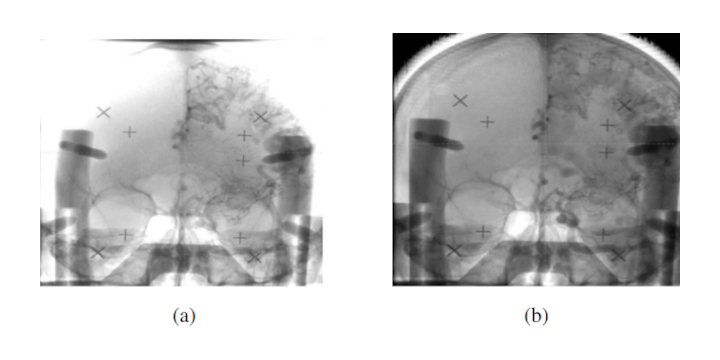Densitometric radiographic imaging with contour sensors
Written by: Francisco Albiol, Alberto Corbi and Alberto Albiol Published on:
Published on: Summary
We present the technical/physical foundations of a new imaging technique that combines ordinary radiographic information (generated by conventional X-ray settings) with the patient’s volume to derive densitometric images. Traditionally, these images provide quantitative information about tissues densities. In our approach, they graphically enhance either soft or bony regions. After measuring the patient’s volume with contour recognition devices, the physical traversed lengths within it (as the Roentgen beam intersects the patient) are calculated and pixel-wise associated with the original radiograph (X ). In order to derive this map of lengths (L), the camera equations of the X-ray system and the contour sensor are determined. The patient’s surface is also translated to the point-of-view of the X-ray beam and all its entrance/exit points are sought with the help of ray-casting methods. The derived L is applied to X as a physical operation (subtraction), obtaining soft tissue- (DS ) or bone-enhanced (D′ B) figures. In the DS type, the contained graphical information can be linearly mapped to the average electronic density (traversed by the X-ray beam). This feature represents an interesting proof-of-concept of associating density data to radiographs, but most important, their intensity histogram is objectively compressed, i.e., the dynamic range is more shrunk (compared against the corresponding X ). This leads to other advantages: improvement in the visibility of border/edge areas (high gradient), extended manual window level/width manipulations during screening, and immediate correction of underexposed X instances. In the D′ B type, high-density elements are highlighted and easier to discern. All these results can be achieved with low-energy beam exposures, saving costs and dose. Future work will deepen this clinical side of our research. In contrast with other image-based modifiers, the proposed method is grounded on the measurement of a physical entity: the span of the X-ray beam within a body while undertaking a radiographic examination.
Keywords
- conventional X-ray imaging
- contour data
- densitometric images
- dynamic range
- depth information
Award
3rd place - Vidal, F. P., Afshari, S., Albiol, A., Albiol, F., Bellot, A., Brun, A. L., Chou, C.-Y., Desbarats, P., García, M., Giovannelli, J.-F., Hatton, C., Henry, A., Kelly, G., Michelet, C., Mihail, R. P., Racy, M., Rouwane, A., Seznec, H., Sújar, A., Tugwell-Allsup, J., and Villard, P.-F.: "X-ray simulations with gVirtualXray in medicine and life sciences". Dirk Bartz Prize for Visual Computing in Medicine and Life Sciences 2025 (Eurographics Medical Prize).
Publications
-
- Vidal, F. P., Afshari, S., Albiol, A., Albiol, F., Bellot, A., Brun, A. L., Chou, C.-Y., Desbarats, P., García, M., Giovannelli, J.-F., Hatton, C., Henry, A., Kelly, G., Michelet, C., Mihail, R. P., Racy, M., Rouwane, A., Seznec, H., Sújar, A., Tugwell-Allsup, J., and Villard, P.-F. (2025). Meuschke, M. & Kuhlen, T. W. (Eds.). “X-ray simulations with gVirtualXray in medicine and life sciences”. Dirk Bartz Prize for Visual Computing in Medicine and Life Sciences 2025 (Eurographics Medical Prize). DOI: 10.2312/evm.20251974
- Albiol, F., Corbi, A., & Albiol, A. (2019). Densitometric Radiographic Imaging With Contour Sensors. IEEE Access 7, 18902–18914. doi:10.1109/ACCESS.2019.2895925
Dissertation
Corbi, A. (2017). Environment recognition applied to particle detectors (Doctoral dissertation). Universitat de València, València, Spain.
Citations
@INPROCEEDINGS{Vidal2025DirkBartz,
author={F. P. Vidal and S. Afshari and A. Albiol and F. Albiol and
A. Corb\'i Bellot and A. L. Brun and C.-Y. Chou and P. Desbarats and
M. Garc\'ia and J.-F. Giovannelli and C. Hatton and A. Henry and
G. Kelly and C. Michelet and Radu P. Mihail M. Racy and A. Rouwane and
H. Seznec and A. S\'ujar and J. Tugwell-Allsup and P.-F. Villard},
booktitle={Dirk Bartz Prize for Visual Computing in Medicine and Life Sciences 2025 (Eurographics Medical Prize)},
title={{X-ray simulations with gVirtualXray in medicine and life sciences}},
year=2025,
editor = {Monique Meuschke and Torsten W. Kuhlen},
publisher = {The Eurographics Association},
ISBN = {978-3-03868-281-3},
DOI = {10.2312/evm.20251974}
}
@ARTICLE{8628952,
author={Albiol, Francisco and Corbi, Alberto and Albiol, Alberto},
journal={IEEE Access},
title={Densitometric Radiographic Imaging With Contour Sensors},
year={2019},
volume={7},
pages={18902-18914},
keywords={X-ray imaging;Calibration;Sensors;Diagnostic radiography;Histograms;Conventional X-ray imaging;contour data;densitometric images;dynamic range;depth information},
doi={10.1109/ACCESS.2019.2895925},
ISSN={2169-3536}
}
@PhDThesis{Corbi2017PhD,
author = {Alberto Corbi},
title = {Environment recognition applied to particle detectors},
school = {Universitat de Val{\`e}ncia},
address = {Val{\`e}ncia, Spain},
year = 2017,
}